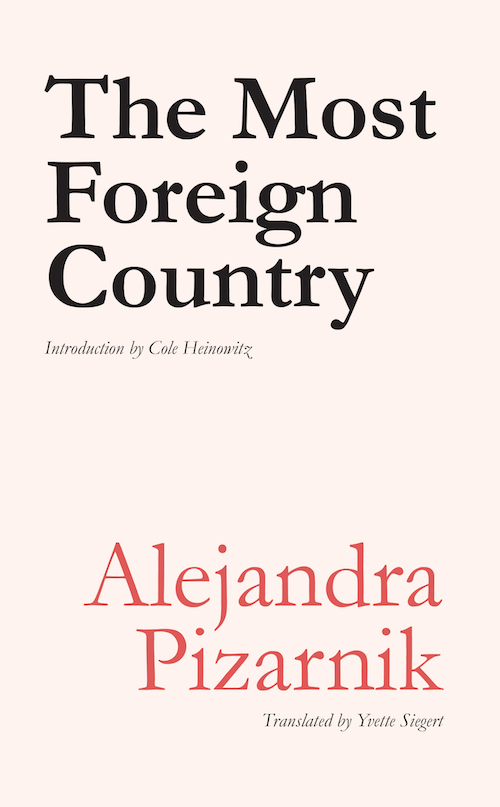Alejandra Pizarnik’s The Most Foreign Country Reviewed at the Constant Critic

Thanks to Ugly Duckling Presse and translator Yvette Siegert, 2017 will see Alejandra Pizarnik’s debut collection, The Most Foreign Country, in print and on shelves. And thanks to Karla Kelsey at the Constant Critic, we have a review of said title. Kelsey begins by looking at the facts of the book, first published while Pizarnik was still a teenager. From the top:
In early 2017 Ugly Duckling Presse will release for the first time in English Alejandra Pizarnik’s debut collection, The Most Foreign Country, translated by Yvette Siegert. First published in 1955 when Pizarnik was 19, she was later to renounce the book, which remained all but buried, even in Argentina, until it was reprinted in Poesia completa, published in 2000, 28 years after her death. This first book begins precociously self-aware with an epigraph by Rimbaud on adolescence: “Ah! the infinite egotism of adolescence, the studious optimism: how the world was full of flowers that summer! Airs and forms dying…” and moves into 24 associative poems that demonstrate the influence Pizarnik’s early work takes from automatic writing. After these poems a suite of six fairly conventional love poems under the section title A Sign Upon Your Shadow conclude the book, beginning a practice Pizarnik was to continue in her later work of ending a volume of poetry with a new title and a handful of poems taking up a new trajectory. While the two sections of the book are substantially different in style and content encouraging us to read the project as two books put together—the first fully realized, the second a new beginning—it also makes sense as a complete work. Considered as a whole, The Most Foreign Country articulates a movement from adolescence into adulthood.
Kelsey goes on to think about Pizarnik’s subject position and her use of doubles:
Pizarnik’s various ways of rejecting convention no doubt attracts contemporary English-language readers to the work, which displays a frank dislocation of subject position while, at the same time, creating poems that are fiercely voiced. English-language poetry’s late 20th-century “either/or” game of a strongly voiced unified subject or the washed-out ambient noise of multiplicity is recent enough to find many readers still hungry for writing that pulls off a slippery self while also having the traction of a life lived. Pizarnik’s later poems in Extracting the Stone of Madness achieve this by creating a stunning array of doubles who stand in for the speaker and operate within surrealist-inflected interior landscapes. The poems are populated by figures such as the “ragged angel,” “she who died of her green dress,” “my shipwrecked selves,” “dead little girls,”—so many little girls—“the solitary ladies who cry,” “the doll in the cage,”—so many dolls—“a girl drawn in pink chalk,” “shadow,” “someone who cries,” “little castaway,” “a statue uninhabited by her self.” In addition to these doubles who are constantly proliferating, shifting, and unwilling to be held down are vehicles of multiplication: mirrors and masks—green masks, paper masks, wolf masks, the mask in your hand.
Pizarnik herself was to draw parallels between her interior struggles and the doubles of her poetry. In a diary entry from 1963 she writes her own version of Rimbaud’s Je est un autre: “To say ‘I’ is to be evacuated, to make a pronoun out of something outside myself.” And, in a move that is likely less appealing to the contemporary reader wary of the tortured female artist narrative, Pizarnik equated herself with her doubles, often referring to herself as “the lost little girl” and “the little castaway.” However, as Cesar Aria proposes in a lecture published in the excellent Music and Literature issue featuring Pizarnik’s work, these metaphors are not only reductive but were useful only as a tool that allowed Pizarnik to write work that transcended such “museficaiton.” Her work, Aria insists, transcends by its living fluidity and pursuit of poetic quality. I can’t help but agree: while Pizarnik may have been a “lost little girl,” the work she left behind, and the accounts we have of her process, tell us that she was also a serious and rigorous reader and writer, famously crafting her mature poems by (for example) writing lines on the chalkboard hanging in her minimalist room, erasing and replacing words until the poem had reached its perfect form.
It's a good one to read in full, all of it, here!


